NeighbourWoods
NeighbourWoods is a residential planting initiative developed to encourage citizens to help grow and preserve Kelowna’s urban forest. Kelowna residents can purchase up to two trees per household, with the exception of the Ivory Silk Japanese Tree Lilac which is limited to 1 per household, for the low price of $50 (plus GST) each.
Since 2010, residents have purchased more than 8,300 discounted trees to plant on their properties.
By purchasing and planting a tree through NeighbourWoods, you're making a positive impact on the environment. To learn more about the benefits of urban trees, visit our Urban trees page.
NeighbourWoods 2025
Tree sales for our the Spring NeighbourWoods program are now closed.
NeighbourWoods tree pick-up will take place on 2 separate days depending on the tree variety purchased. Pick-up dates are as follows:
- Thursday, May 1 for Admiration Oak, Crimson Sentry Norway Maple, Ivory Silk Japanese Tree Lilac and Northern Acclaim Honey Locust.
- Friday, May 2 for Amur Cork Tree, Ginko Maindenhair, Parkland Pillar Birch and Tulip Tree.
For those picking up more than one tree variety, please pick-up your trees on Friday, May 2.
Pick-up on these days is from 12 - 6:30 p.m. at the Mission Recreation Park Arboretum, 4105 Gordon Drive. Please bring your receipt (if applicable), proof of residency and a vehicle that's appropriate for transporting your tree(s).
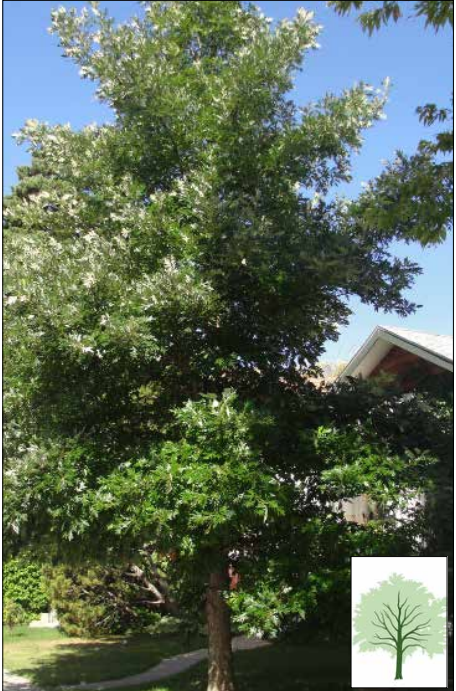

Quercus x 'Jefmir'
Height: 40 feet Spread: 30 feet Sunlight: Full sun Moisture: Drought tolerant but prefers moist soil Soil type: Not particular to soil type or ph Hardiness Zone: 2
Description: A fantastic choice for homeowners looking to add a stately and hardy tree to their landscape. This hybrid oak grows up to 40 feet tall and 30 feet wide, featuring a distinctive pyramidal shape. It's glossy, dark green foliage provides a lush canopy, turning golden in the fall and often retained into winter, adding seasonal interest.
Characteristics: The tree's shaggy, peeling bark adds unique texture and visual appeal. Extremely tough and adaptable, the Admiration Oak thrives in full sun and is highly tolerant of urban conditions. Its low-maintenance nature and impressive longevity make it a valuable addition to any home garden.
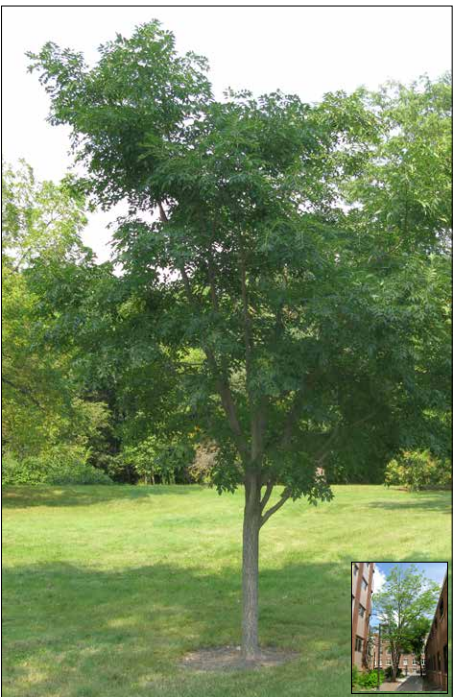

Phellodendron amurense
Height: 40 feet Spread: 40 feet Sunlight: Full to partial sun Moisture: Good for dry sites and can tolerate drought Soil type: Alkaline Hardiness Zone: 3
Description: A wonderful addition to any homeowner's landscape. This tree can grow up to 35-50 feet tall and features deeply furrowed, spongy bark that adds a unique texture to your garden.
Characteristics: Its compound leaves turn a stunning yellow-bronze in the fall, providing a beautiful seasonal display. The tree also produces small green flowers in clusters from May to June, adding a touch of elegance. Hardy and adaptable, the Amur Cork Tree thrives in both sun and shade, making it suitable for various garden conditions. Its distinctive yellow inner bark and low-maintenance nature make it a practical and appealing choice for enhancing your home's landscape.
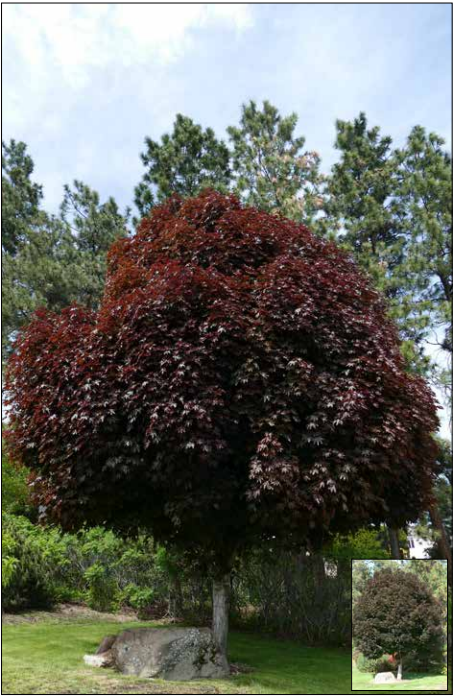

Acer platanoides 'Crimson Sentry'
Height: 33 feet Spread: 16 feet Sunlight: Full sun Moisture: Tolerates occasional drought and dry sites Soil type: Tolerates a wide variety of soil Hardiness Zone: 4-9
Description: A compact visually striking tree perfect for small gardens and urban settings. This tree adds year-round colour and structure to any landscape.
Characteristics: It features bright crimson leaves in spring that turn deep maroon-purple in summer and vibrant crimson in fall. Its columnar shape make it ideal for lining pathways. Hardy, it tolerates urban conditions and requires minimal maintenance.
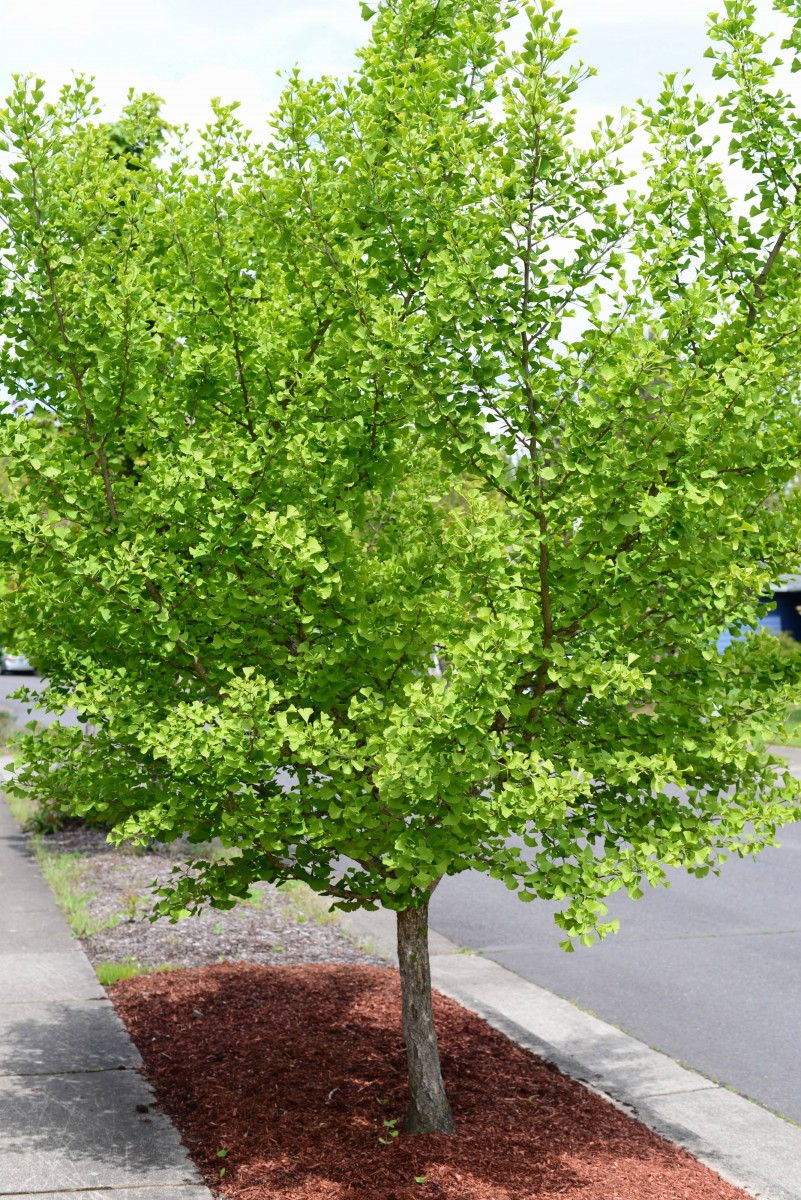

Ginko biloba
Height: 40-50 feet Spread: 20-30 feet Sunlight: Full sun Moisture: Moderate Soil type: Tolerant of most Hardiness Zone: 3-8
Description: The ginkgo is a large, unique tree in the Okanagan. Considered to be a ‘living fossil’; they are the only surviving member of a group of ancient plants that lived about 150 million years ago.
Characteristics: Requiring relatively little maintenance, ginkgos tolerate most urban conditions including salt, heat and air pollution. They are generally pest free and are a great shade tree. A gingko can grow to be over 50 feet tall at maturity, with a spread of up to 30 feet. It has a high canopy with a typical clearance of 8 feet from the ground and should not be planted underneath power lines or in smaller spaces. It grows at a slower rate for the first few years but then will accelerate, and under ideal conditions can be expected to live for over 150 years. Distinctive fan-shaped rich green leaves change to a stunning bright yellow in the fall and stay on for several weeks. Our stock is an all-male (fruitless) cultivar which doesn’t produce messy seeds.
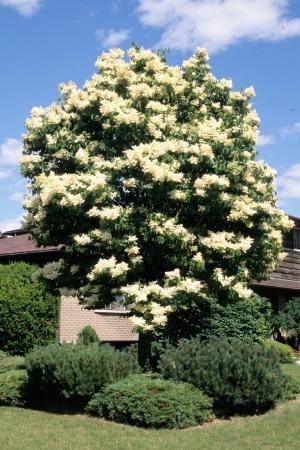

Syringa reticulata ‘Ivory Silk’
Height: 20 feet Spread: 10-20 feet Sunlight: Full sun Moisture: Average, but can tolerant periods of drought Soil type: Not particular to soil type or pH Hardiness Zone: 4
Description: A first rate accent tree adorned with frothy upright panicles of creamy white flowers in early summer. Interesting steel-gray bark and a dense upright habit make it an ideal choice for small landscapes. Prefers well-drained soils.
Characteristics: Ivory Silk Tree Lilac will grow to be about 20 feet tall at maturity, with a spread of about 14 feet. It has a low canopy with a typical clearance of 5 feet from the ground, and is suitable for planting under power lines. It grows at a medium rate, and under ideal conditions can be expected to live for 40 years or more. This tree should only be grown in full sunlight. It prefers to grow in average to moist conditions, and shouldn't be allowed to dry out. It is highly tolerant of urban pollution and will even thrive in inner city environments. Shape is upright spreading becoming rounded. Foliage is dark green that turns golden yellow in the fall.
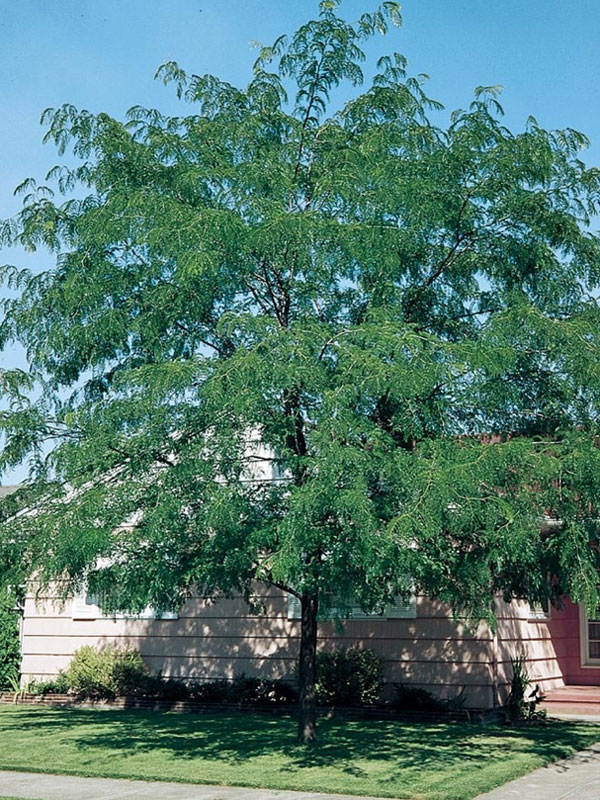

Gleditsia triacanthos 'Harve'
Height: 40-50 feet Spread: 20-30 feet Sunlight: Full sun Moisture: Tolerates drought and dry sites Soil type: Moist well drained can tolerate clay Hardiness Zone: 3b
Description: A wide spreading tree that will be sure to lend your property some cool shade in the hot summer months.
Characteristics: The honey locust can grow to a height of 50 feet and a width of 30 feet. Its small leaves and wide spreading crown are able to provide some dappled shade to your yard. The small leaves will also make fall cleanup a breeze after you have finished enjoying the stunning golden yellow fall colour. Shape is broadly pyramidal. Foliage is fine textured, medium green and turns yellow in the fall.
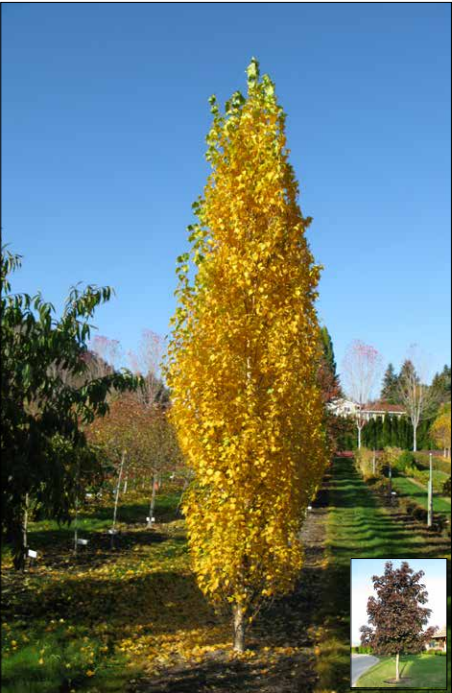

Betula platyphylla 'Jefpark'
Height: 33 feet Spread: 6 feet Sunlight: Full sun Moisture: Drought tolerant but prefers moist soil Soil type: Well drained and moist, can tolerates a variety of soils Hardiness Zone: 3
Description: An excellent choice for small spaces or as vertical accent in the landscape. It provides good shade and visual interest to any garden or yard.
Characteristics: A tall, narrow tree with striking white bark and dark green leaves that turn yellow in the fall. This tree is relatively low-maintenance and resistant to pests and diseases.
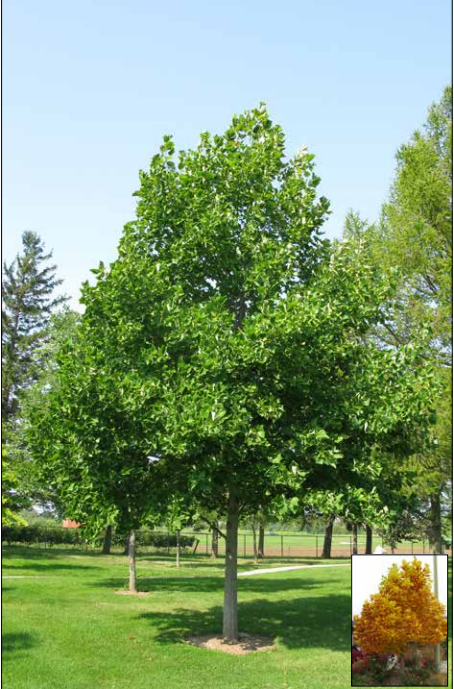

Liriodendron tulipifera
Height: 70 feet Spread: 30-60 feet Sunlight: Full sun Moisture: Moist well drained soil, drought tolerant once established Soil type: Moist well drained Hardiness Zone: 4
Description: A magnificent addition to any homeowner's landscape. This tree can grow up to 70 feet tall and 30-60 feet wide. It features distinctive, tulip-shaped flowers that are yellow with touches of green and orange, blooming in late spring.
Characteristics: The tree's broad, lobed leaves turn into a vibrant golden yellow in the fall, providing a stunning seasonal display. The Tulip Tree thrives in full sun and prefers moist, well-drained soil. Its rapid growth and strong wood make it a durable and low-maintenance choice for your garden. Additionally, it attracts pollinators like bees and hummingbirds, adding life and movement to your outdoor space.
Please note that online tree sales are now closed for spring.
If you don’t already have a recreation account, you will need to set one up by calling 250-469-8800. You can also pay by credit card over the phone by calling 250-469-8800, or visit the friendly staff at Parkinson Recreation Centre to pay by cash, debit or credit card.
Tree orders can be cancelled as long as there’s someone on the waitlist for a tree. A $5 cancellation fee will apply.
Trees available in spring 2025 included: Admiration Oak, Amur Cork Tree, Crimson Sentry Norway Maple, Ginko Maidenhair, Ivory Silk Japanese Tree Lilac, Northern Acclaim Honey Locust, Parkland Pillar Birch, and the Tulip Tree.
Tree size will vary depending on the tree. Expect to receive a tree that is approximately six- to 12-feet tall.
If a tree variety has sold out, you can still waitlist for a tree online, by calling 250-469-8800, or in-person at the Parkinson Recreation Centre. Payment is not required for waitlist.
The 2025 NeighbourWoods pick-up event will depend on the tree variety purchased.
Pick-up dates are as follows:
Thursday, May 1 for Admiration Oak, Crimson Sentry Norway Maple, Ivory Silk Japanese Tree Lilac and Northern Acclaim Honey Locust.
Friday, May 2 for Amur Cork Tree, Ginko Maindenhair, Parkland Pillar Birch and Tulip Tree.
For those picking up more than one tree variety, please pick-up your trees on Friday, May 2.
Individuals can pick-up their tree on their respective tree's day between 12 - 6:30 p.m. at the Mission Recreation Park Arboretum, 4105 Gordon Drive.
Please bring your receipt (if applicable), proof of residency and a vehicle that’s appropriate for transporting your tree(s). Trees not picked up by the end of Friday, May 2, will be considered donated to the City of Kelowna for public planting.
The following information is adapted from the International Society of Arboriculture:
- The ideal time to plant trees is during the dormant season (fall or early spring)
- Exercise care in the storage and transportation of nursery stock to avoid stress or mechanical damage. Lift the tree by the root ball instead of the trunk. Don't allow roots to dry out.
- Before digging, locate all underground utility wires. Call (800) 474-6886. Please try to plant the tree where it will shade your home.
- Dig a shallow, broad planting hole, with the hole widest at the top and sloping sides; at least 450-600mm (18-24 in) wider than the root ball diameter (or three to fives times wider than root ball diameter in compacted soils). Dig only to the same depth as the root ball. Identify the trunk flare (point where the roots spread at the base of the tree) to determine the proper depth of the hole.
- Water tree in pot. Remove the pot. Score and loosen the roots. Place the tree in the hole, at the proper height. Don't plant the tree lower than the trunk flare; it's better to plant a few inches higher than the trunk flare to allow for some settling. Straighten the tree and gently backfill the hole.
- When backfilling, use the same soil that came out of the hole; if a different type of soil is used to fill the hole, this may result in problems with drainage around the root ball. If the native soil is extremely poor, topsoil or soil amendments may be necessary, but mix at least 50 per cent of the native soil in with any additional amendments; topsoil should match the same texture as the native soil and the hole should be much wider to allow for growth.
- Firm the soil but don't pack. Water thoroughly. Remaining soil may be mounded into a berm to collect water in the root zone (leave a gap in the berm if the soil is clay). Fertilizer application at the time of planting isn't recommended.
- Stake the tree only if necessary, as staked trees tend to develop weaker trunks and smaller root systems. Remove support staking after the first year of growth to avoid girdling the stem.
- Mulch the base of the tree with 50- 100mm (2-4 in) of organic matter (e.g. straw, bark, peat moss, wood chips, leaf litter) to hold in moisture and protect against extreme soil temperatures. Keep mulch at least 25-50mm (1-2 in) away from the trunk to prevent decay. Don't apply too much mulch.
- Water the tree for the first three years of establishment, about once a week during the growing season (more often during hot weather). Keep the soil moist but not soaked.
- Prune sparingly after planting; corrective pruning should not be done until the tree has experienced a full year of new growth
- Tree spacing will vary depending upon the geometry of the site and landscaping objectives. Consider the volume of soil available to each tree. If the soil volume is too low, then trees will be competing with each other for available water and nutrients. Keep in mind the mature size of the tree so that tree canopies won't become too closely packed as they grow.
- The three main reasons trees die after transplanting are underwatering, overwatering and when they're planted too deeply






